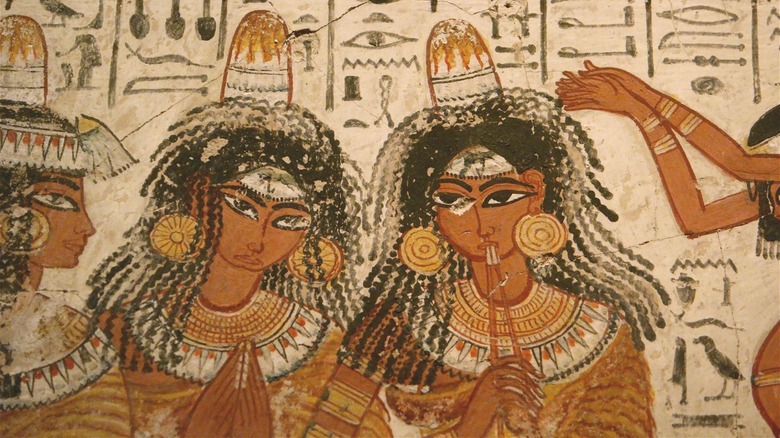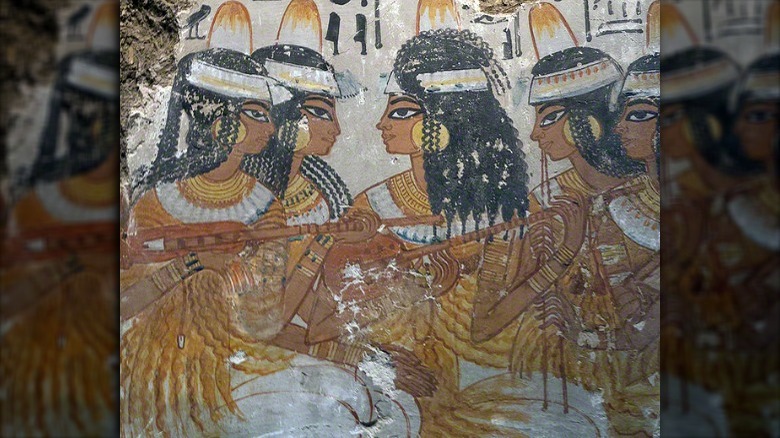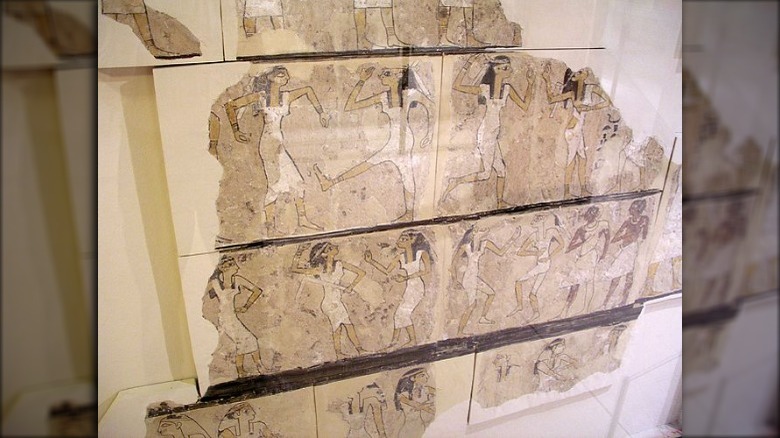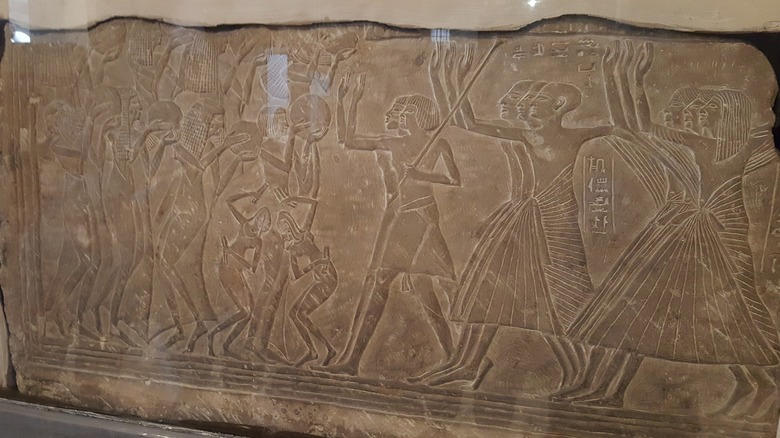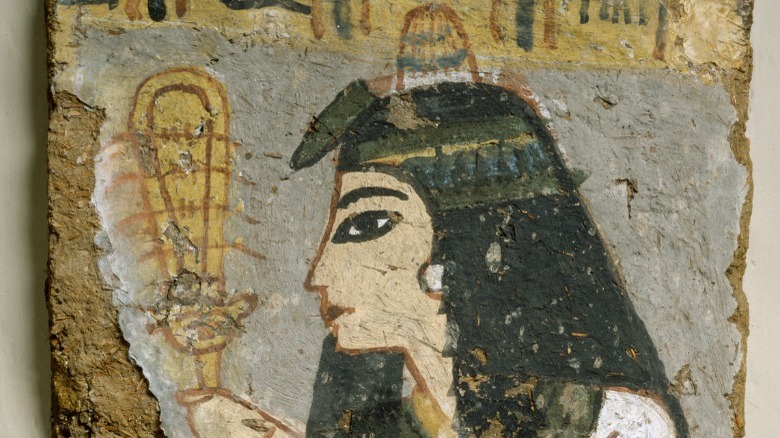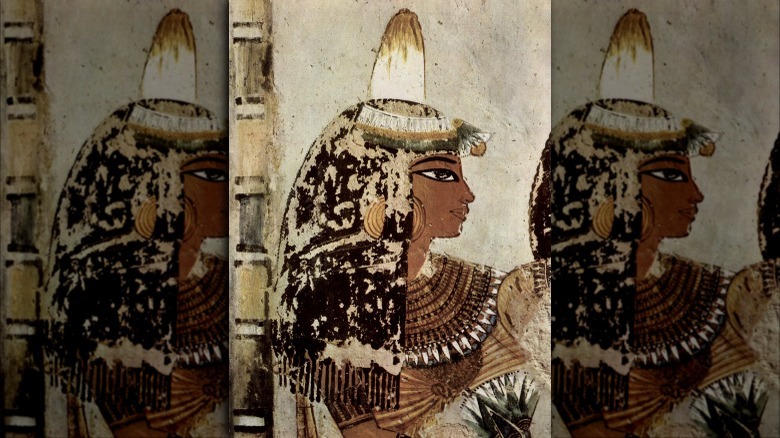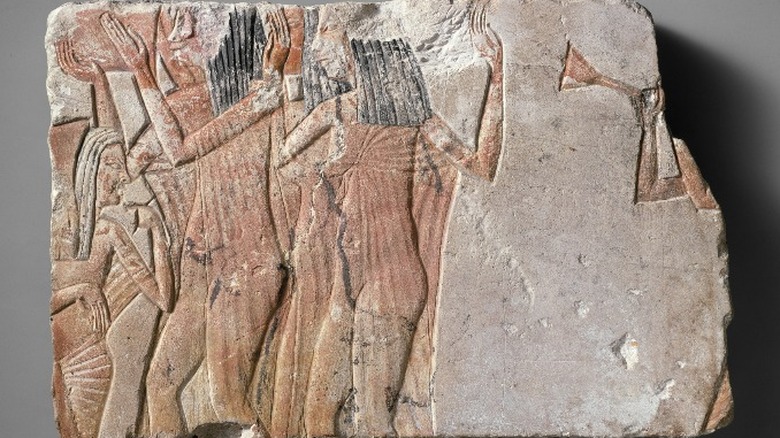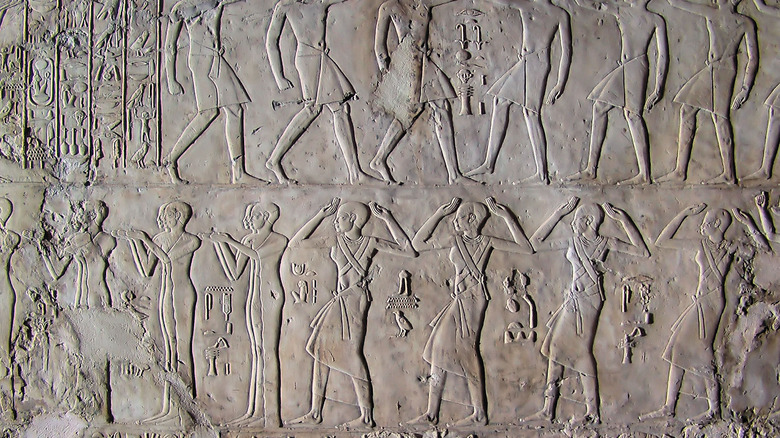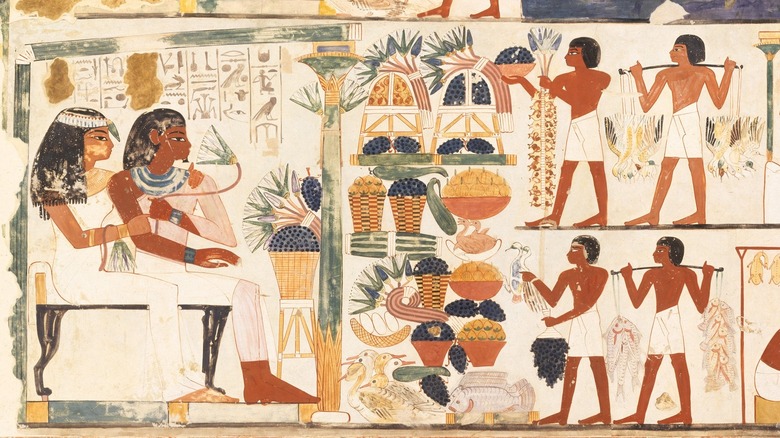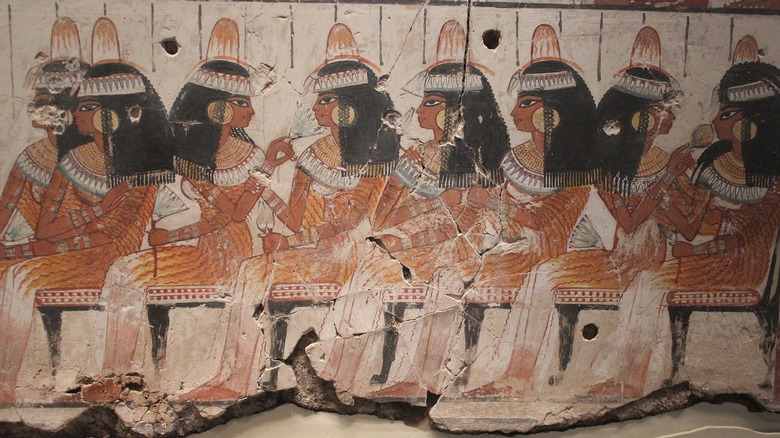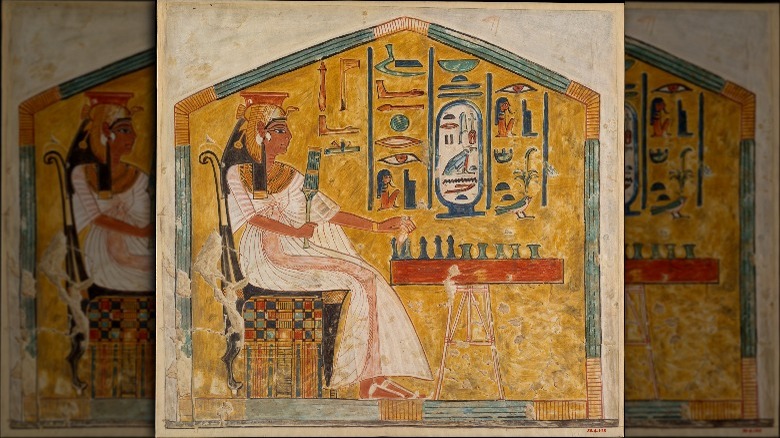What It Was Really Like To Party Like An Ancient Egyptian
If there's anything that holds true about the human species, regardless of time, place, belief, or other factors, it's that we like to get together. Socialization is pretty key to maintaining a culture and social structure, after all, and sometimes it's just really nice to hang out with friends for an evening. Now, sometimes those get-togethers take pretty different forms, whether it's the relatively staid and structured world of Regency balls or a shockingly lavish 18th-century feast in China (via History).
But, when it comes to parties of the ancient world, it seems like it would be terribly hard to beat some people. The Greeks knew how to down their wine and recite poetry, while the Romans held notorious parties. But, all too often, we forget the sort of soirees put on by the ancient Egyptians. And we really shouldn't, since it seems like the Egyptians really knew how to get down.
We might also feel a bit closer to our ancient compatriots when we consider some of the similarities between then and now. Sure, they didn't have the option to fall back on a movie if things got dull, and we aren't topping our heads with incense cones (not yet, anyway). But they certainly seemed to love their fine foods, entertainments, and adult beverages just like many of us today. Perhaps, given a time machine and a crash course in ancient languages, you'd find that partying like an ancient Egyptian is more interesting than you thought.
Just about any occasion could mean a party
Like so many people in history before and after their time, the ancient Egyptians seem to have been primed to party whenever they could. Sometimes, according to the British Museum, these were grand state affairs presumably meant to boost the power, glory, and public image of the Egyptian royals. After all, what pharaoh wouldn't want to show off the glory and power of Egypt to foreign dignitaries with a refined and very, very expensive dinner? Other occasions would have been intended to honor the gods and religious life of ancient Egypt, which sometimes demanded a good party in a deity's name.
Sometimes, parties appear to have held a more everyday purpose, like celebrating a marriage or the birth of a new child. Much of the evidence we have of parties comes from things like tomb paintings in the burial places of rich folks (after all, they were the ones with the cash to spend on elaborate murals that would be presumably buried forever). Yet, it's hard to believe that middle- or lower-class Egyptians of the time would have passed on a good party, either, though they may have had to skip some of the more elaborate entertainments of other get-togethers, like professional acrobats, dancers, and storytellers. And maybe, though it hasn't necessarily been recorded in grand monuments or the tombs of rich people, ancient Egyptians also like to put on a party just because they wanted to do so.
Ancient Egyptian parties could have a serious religious purpose
While some ancient parties were probably an elaborate excuse to hang out with friends or to show off your most fashionable linen dress to the neighbors, others were held to keep up the spiritual life of ancient Egypt. To that end, we have multiple records of different religious festivals that, for many, would have been a large-scale — if pretty orchestrated — party.
According to the World History Encyclopedia, quite a few public festivals seem to have been rituals of thanksgiving, with everyone paying homage to the gods and perhaps asking a favor or two. That was part of the days-long Wepet-Renet festival, which honored the rebirth of the underworld god Osiris, who also often oversaw agriculture and fertility while he was at it. But the festival also had plenty of feasting and, we assume, could get pretty jovial at times given the drinking going on.
The Opet festival, which honored the sun god, Amun, was also marked by food, drinks, and sweets distributed to the crowd as they gathered to see Amun's statue carried in procession. And at least two occasions, the Tekh and Hathor festivals, were true parties, where people intentionally overindulged in alcohol and got down with singing and dancing (and maybe also some attractive people) — for religious purposes, of course.
There was an entire festival for getting drunk
If staid high-class banquets and orchestrated religious festivals aren't quite your idea of a good party, then the ancient Egyptians would still have you covered. For they had one particular festival where an important god pretty much demanded that you go utterly wild, not unlike the hedonistic hotel-trashing rock bands of the 20th century. Only, imagine if somehow Nirvana was utterly destroying Kurt Loder's room for the purposes of legitimate religious worship in a way that would make a priest nod in acceptance.
That would be the Tekh festival, according to the World History Encyclopedia. It was held in remembrance of an Egyptian myth whereupon the lion-headed goddess Sekhmet was inadvertently tipped into a highly destructive bloodlust that threatened everyone. The gods dye some beer blood-red, get Sekhmet wickedly drunk, and then watch as she passes out and the violence stops. Eventually, she wakes as the far more chill goddess Hathor. In honor of this transformation, celebrants would get utterly inebriated, enjoy music and dancing, and canoodle in honor of the goddess.
According to NBC News, archaeologists have uncovered physical evidence of the Tekh festival, including a "porch of drunkenness" at an ancient temple sponsored by pharaoh Hatshepsut. The drinking was apparently meant to help people connect more deeply with the dual-natured goddess, who could let loose and then redeem herself. Revelers here would drink beer, while a later festival, the "festival of the beautiful valley," demanded the consumption of wine.
Partying ancient Egyptians had to put on a lot of makeup
Let's assume that a massive rager held in the local temple isn't quite your speed. Maybe you'd rather have a nice get-together with some friends or, if you're feeling a bit more up to it, a few more people from the neighborhood. For the ancient Egyptians, this would have taken the form of a smaller party or banquet. And, considering that perhaps people haven't changed all that much over the millennia, many would have wanted to use a party as a bit of an opportunity to show off.
When it came to personal appearance during a party, that would have meant that ancient Egyptians needed to put on their best face — literally. For richer people, says CNN, that might start with the sort of skin preparations that sound like the multistep rituals of today, with exfoliants, moisturizers, and face masks. A servant would help their employer with preparing and applying the rest of the makeup, which included eyeshadow and eyeliner whose basic components would be made by grinding them as-needed on a palette.
Both men and women wore makeup, which offered not only enhanced looks but also some level of protection. Thick, dark eyeliner, for instance, would have cut back on some of the glare delivered by the harsh desert sun, not unlike the way some American football players will smear black face paint just beneath their own eyes.
Ancient Egyptian partiers may have worn incense cones on their heads
For many ancient people, just like today, looking good was just part of making a fine entrance to the next party. You had to smell good, too. CNN notes that people at their pre-party toilette could have smeared incense on their armpits as a deodorant, along with scented oils that worked as moisturizers. But, for some trendy partygoers in certain periods of ancient Egyptian history, it didn't stop there.
That's because some people in Egypt's ancient past also wore cones of incense on their heads. Previously, as Science notes, it was thought that these were made out of a waxy substance that would slowly melt over the course of an event, continuously perfuming the wearer. And, for a long time, that was the best guess, given that the only way we knew about these cones was from artworks like tomb paintings that showed these in use at parties in the afterlife. But the discovery of head cones left behind in the graves of relatively lower-class Egyptians not only disabused many of the notion that these accessories were for fancy folk only, but the melting theory started to disintegrate, too.
Then again, it's possible that these were mock incense cones that didn't have the right sort of composition to slowly melt, meaning that the "real deal" was reserved for high-class people who could afford the genuine article and use it to show off at rituals and social events.
Ancient Egyptian parties would have been full of music
It's easy to imagine that humans, no matter the time or place, would have occasionally fallen victim to the insidious lull in the conversation. For some, it's no big deal and a natural part of any gathering, but others may find that sort of moment downright agonizing. So it can be a bit of relief to have some music going as background noise or, depending on the party, the main event itself.
The ancient Egyptians also loved music, says the World History Encyclopedia, with musicians represented in artworks throughout the different eras of the kingdom's history. They would have worked from memory, with no sheet music or other forms of notation that we're aware of. But the instruments would have been pretty familiar to modern listeners, with soloists and ensembles playing things like harps, flutes, and drums. There would have also been singers and even conductors to help groups keep time.
Much like modern musicians, the ancient Egyptian music-makers would have at least partially earned their keep by entertaining members of the upper classes at banquets and other parties. They would have also been fixtures of social and religious ceremonies, providing accompaniment to temple rituals meant to please the gods (and it didn't hurt if the pharaoh or other notables liked it, too, while the musicians were at it).
Egyptian partygoers would have watched skilled dancers
As if musicians and conversation weren't enough entertainment for ancient Egyptian partiers, they might also have enjoyed the physical prowess of dancers and acrobats, too. According to the World History Encyclopedia, dancers were a frequent feature of social events. Many appear to have worked with musicians or even accompanied themselves while dancing. If some artworks are to be believed, dancers could be pretty energetic, too, doing backbends and flips while oftentimes wearing minimal clothing.
Though it seems as if the ancient Egyptians had fewer hang-ups about moving or showing off their bodies than other societies, the art of dance still appears to have been at least somewhat connected to class. Judging from the visual evidence and a few scant texts, it seems that only lower-class folks danced in public. That could be because professional dancers were often seen sporting as little clothing as possible, sometimes to the point where they wore only a string of beads or some other bits of jewelry. While the Egyptians weren't usually shy about their bodies, rich folks did seem to cover up more overall.
But still, some people as high-ranking as the pharaoh may have busted some moves in private rituals. Dance and moving one's body seem to have been pleasing to quite a few gods. And, of course, it's not hard to believe that some people, regardless of class and maybe emboldened by some good wine or beer, would have spontaneously danced amongst themselves, too.
The rich would have dined well at ancient parties
For many, a truly good party must have not just good tunes or people decked out in their finest gear but a good culinary array. After all, how many of us have been disappointed by a get-together which would have been perfectly fine, if only the host had given a thought to the snacks?
In this respect, the ancient Egyptians knew how to get it done. If you were able to attend an ancient Egyptian banquet — and also if you could convince the host the you were kind of a big deal — you would dine very well indeed. According to Rawi Magazine, higher-class occasions could sport elaborate banquets featuring delicacies like figs, cakes, duck, fish, and choice cuts of beef. Drinks included wine and that Egyptian classic, beer. Some might have also enjoyed shedeh, a fermented beverage made with pomegranates.
Some ancient guests appear to have really enjoyed those drinks, though maybe the stuffiest parties would have looked down on serious indulgence. As Rawi notes, tomb paintings show the consequences of a wine-, beer-, and shedeh-fueled rager, with some people carried out of a rocking banquet and others emptying the contents of their stomachs, not unlike attendees of a modern frat party. It fit pretty well with the commonly espoused Egyptian advice to live life to the fullest, though anyone nursing a hangover in the heat of the next morning may have wished they held back just a bit.
Ancient Egyptian parties could still be pretty hierarchical
While we don't have many records of a lower-class ancient Egyptian party, it's easy to believe that they were likely fairly casual affairs with less of the fanciful trappings seen in rich peoples' tomb paintings. And, as one might hope, they might have also been less invested in reinforcing power structures of the day. At any rate, it seems as if the higher-class folks whose party habits were recorded certainly were interested in keeping the hierarchy nice and stratified, even when they were supposed to be relaxing.
According to Heritage: Journal of Multidisciplinary Studies in Archaeology, banquets could be seated according to rank. The highest-status guests were closest to the party hosts, while your status decreased the further you were seated from the big names at the head of the table. What you were sitting on mattered, too. If you were sitting in a highly decorated chair, that meant you were a pretty big deal overall. And a more plain seat wasn't so bad, since the schlubs at the end of the table were relegated to sitting on mats or even just the bare ground.
Even what you were served might be a reflection of your place in society. Per Rawi Magazine, those sitting on the floor at the far end of the table would still certainly be fed decently enough, but it wouldn't necessarily be the wider variety of finer stuff being served to the guest of honor a few seats away.
Rich guests would have worn the most fashionable clothes
If you're going to a party where you've planned to make a real impression, with trendy makeup and your best jewelry, then you simply must put on your fanciest clothes, too. After all, why bother to make your servant grind up the best kohl and get out your shiniest pectoral necklace if your dress and wig are going to be duds? Even though they lived thousands of years ago, it's pretty clear that, like so many of us today, the ancient Egyptians often dressed to impress.
According to the Word History Encyclopedia, the earliest dynasties of ancient Egypt saw all classes in pretty similar clothing, with variations on the quality of cloth and construction. Both men and women wore mid-length kilts, though upper-class people certainly tended more towards wearing flashy jewelry. Women might have also shown off high-quality linen with finely woven tunics. Some more complicated trends came in and out as time went on, like the New Kingdom mania for elaborately embroidered and pleated kilts and dresses.
Those sorts of fanciful fashions can be seen in tomb paintings from around that time, as the journal Heritage notes. However, class sneaks in here, too, as the typically lower-class (though still very skilled) entertainers like dancers and musicians aren't nearly as well-dressed as some of the people enjoying the performances. In some cases, apart from some jewels and other decorative elements, they're depicted wearing next to nothing at all.
